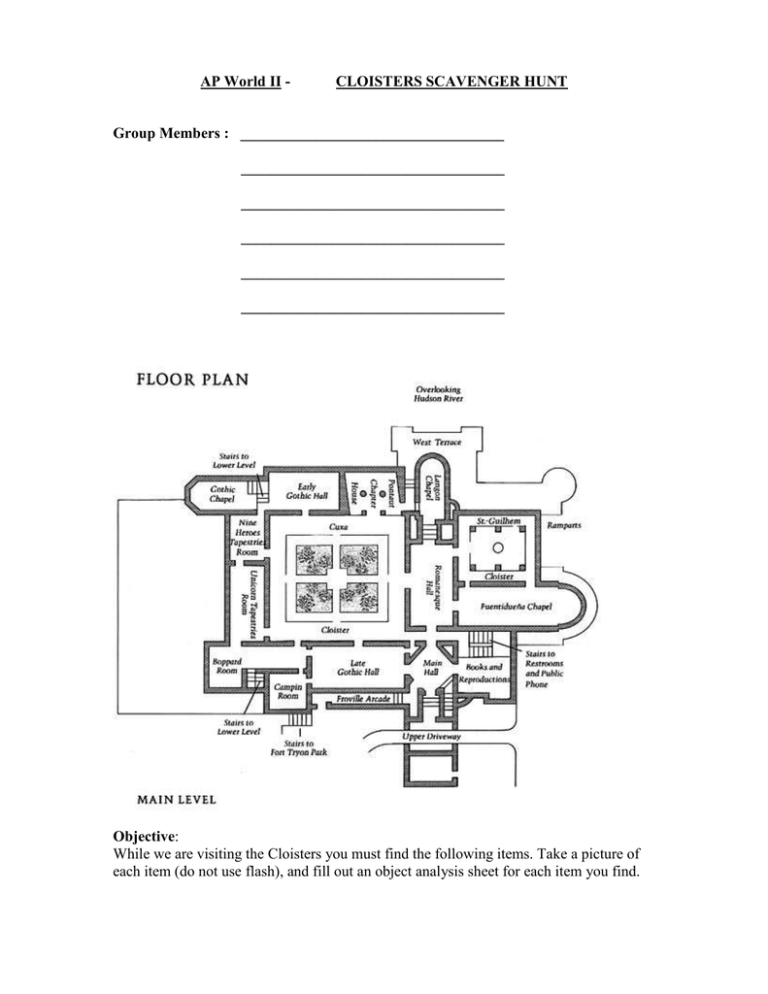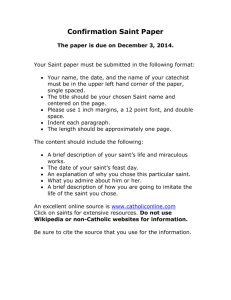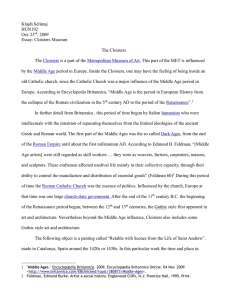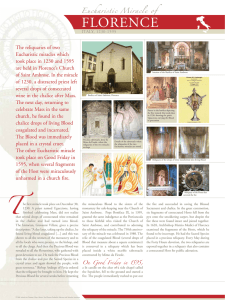AP World II - CLOISTERS SCAVENGER HUNT
advertisement

AP World II - CLOISTERS SCAVENGER HUNT Group Members : ___________________________________ ___________________________________ ___________________________________ ___________________________________ ___________________________________ ___________________________________ Objective: While we are visiting the Cloisters you must find the following items. Take a picture of each item (do not use flash), and fill out an object analysis sheet for each item you find. GROUP 1 1. 2. 3. 4. 5. The Adoration of the Shepherds - 14th Century – Bartolo de Fredi Portal from the Church of San Leonardo al Frigido ca. 1170-1180 Seated Bishop ca. 1495 – Tilmon Riemenschneider The Virgin Mary and the Five Standing Saints Above Predella Panels 1440-1446 Plaque with the Fountain of Youth ca. 1320-1340 GROUP 2 1. 2. 3. 4. 5. Panel with Hunting Scenes ca. 1350 – France The Bishop of Assisi Giving a Palm to Saint Claire ca. 1360 – Germany Triptych with the Passion of the Christ 1475-1485 Bursa Reliquary – early 10th Century Theodosius Arrives at Ephesus ca. 1200-1205 GROUP 3 1. 2. 3. 4. 5. Diptych with Coronation of the Virgin and the last Judgment ca. 1260-1270 Tomb Effigy of Jean d’Alluye – mid-13th century The Temptation of Saint Anthony, 1532 Reliquary Shrine – 2nd quarter of the 14th Century, Jean de Touyl King Arthur: Tapestry Fragment from the Series, Five Worthies and Attendant Figures ca. 1400-1410 6. Chalice, Paten, and Straw ca. 1230-50 GROUP 4 1. 2. 3. 4. 5. 6. The Intercession of Christ and the Virgin, early 15th Century – Lorenzo Monaco Roundel with Scenes of the Attack on the Castle of Love ca. 1320-1340 – French Chapter House from Notre-Dame-de-Pontaut, 12th Century Saint James the Greater, ca. 1489-1493, Gil de Siloe Arm Reliquary, ca. 1230 The Cloister Cross – 12th century GROUP 5 1. 2. 3. 4. 5. 6. Saltcellar - mid-13th century, France Aquamanile in the Form of a Ram – ca. 1250-1350, England The Annunciation Triptych, ca. 1425-1430 by Robert Campin Pieta (Vesperbild), ca. 1395-1400 The Mater Dolorosa, ca. 1480 – Peter Hemmel von Andlau Plaque with Saint John the Evangelist, early 19th Century Group Members : ___________________________________ ___________________________________ ___________________________________ ___________________________________ ___________________________________ ___________________________________ OBJECT ANALYSIS WORKSHEET The museum object label will give you some information for these questions; others will require careful observation of the object and thinking about the clues that you get from the objects. 1. PHYSICAL QUALITIES OF THE OBJECT A. Describe the material from which it is made. (Wood, clay, marble, etc.) B. Can you tell how the object was made? (Carved, molded, cast, etc.) C. How would you describe the texture of the surface of the object? D. What size is it? E. Is it a complete piece or a fragment of a larger work? F. What shapes and colors are used in the object? G. Is anything printed, stamped, or written on it? 2. SUBJECT MATTER A. Who or what is represented in the piece? B. Does the piece tell a story? If so, what is happening? 3. USES OF THE OBJECT A. What might it have been used for? B. Who might have used it? C. Where might it have been used? D. When might it have been used? 4. WHAT DOES THE OBJECT TELL US A. What does it tell us about the life of the people and the time in which it was used? B. What does it tell us about the technology of the time in which it was made and used? C. Can you name a similar item that we use today? 5. WHAT ELSE WOULD YOU LIKE TO KNOW ABOUT THE OBJECT A. What questions do you have about it? B. What resources could you use to answer your questions?










